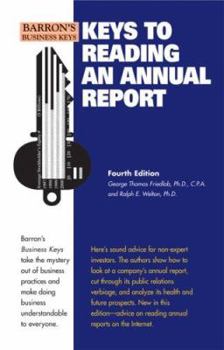Keys to Reading an Annual Report
How to cut through the public relations jargon and analyze a company's financial health and future prospects as it's spelled out in an annual report. Sound advice for non-expert investors in the stock... This description may be from another edition of this product.
Format:Paperback
Language:English
ISBN:0764139150
ISBN13:9780764139154
Release Date:May 2008
Publisher:Barrons Educational Series
Length:204 Pages
Weight:0.60 lbs.
Dimensions:0.4" x 5.3" x 8.3"
Customer Reviews
5 ratings
easy and good!
Published by Thriftbooks.com User , 15 years ago
a good book that explains in simple words what financial statements are about! very nice!
Succinct and Informative
Published by Thriftbooks.com User , 20 years ago
This book is very succinct and the explanations for each accounting concepts are very easy to understand and easy to remember. The "Red Flags" after each concept are very useful in pointing out all the possible problems that may arise. While the strengths of this book is his conciseness, it does require you to have some basic accounting background. Otherwise, some of the explanations may seem confusing. Having said that, if i am reading an annual report, I would definitely want to have this book beside me. Happy reading!
Great Little Book To Help You Understand Financial Reports
Published by Thriftbooks.com User , 22 years ago
"Keys To Reading An Annual Report" by George Thomas Friedlob and Ralph E. Welton is a wonderful, little book for all investors. Each of the fifty, three-or-four-page sections covers a key concept that investors should understand when reading a public company's annual report and other financial statements. "Keys To Reading An Annual Report" is no substitute for a complete text about financial statement analysis, such as "The Analysis And Use of Financial Statements," but "Keys To Reading An Annual Report" is an excellent first read for new investors who are learning to understand financial statements. And, experienced readers of annual reports will probably find this book a useful review.Some of the fifty key topics covered include:--SEC Forms 10-K, 10-Q, and the 8-K --Current Assets --Cash and Receivables --Cost of Goods Sold and Inventories --Property, Plant, and Equipment --Depreciation --Intangibles and Other Assets --Depletion and Amortization --Current Liabilities --Bonds and Amortization --Owner's Equity --Classes of Stock --Treasury Stock --Discontinued Operations --Ratio Analysis--Taxes and Tax Deferrals Many of the topics "Red Flag" things to which investors should pay special attention. For example, the chapter about Depreciation Red Flags: "The basis for long-lived asset valuation is historical cost. Because depreciation does not measure actual decline in value, the net book value of a long-lived asset (historical cost - accumulated depreciation) is not a good measure of the cost of replacing the asset. Neither is net book value a good measure of what the asset would bring if sold." (i.e., depreciation expense is a way of expensing the long-lived asset. And, the balance sheet only lists the so-called "unexpired cost.")The red flag also discusses the difficulty in comparing depreciation across different companies because of the different ways depreciation may be computed.The section about Treasury Stock tells us: "Stock Issued by a company may later be reacquired by the company. In some cases, the company may retire or cancel this stock. When reacquired stock is not retired or canceled, it is referred to as treasury stock." (there is a nice glossary at the end of the book.).Friedlob and Welton point out that treasury stock is not an asset. "A company cannot create an asset by holding stock in itself."However, because the reacquired stock may have been reacquired at a different price than it was originally issued, the wealth within the company can change in such a treasury stock transaction. For example, suppose stock is issued for $20 per share, but reacquired for $2 per share (it's an internet company!), then, somehow, the company has taken in $18 per share on the transaction. How is this accounted for in the financial statements?Friedlob and Welton explain: "Just as treasury stock is not an asset, a loss or gain cannot result from treasury stock transactions. 'Things' happen that you and I would call a 'loss' (reacquiring treasury sto
Keys to Reading an Annual Report
Published by Thriftbooks.com User , 22 years ago
This small manual concisely and succinctly presents the major elements of financial statements in easy to read, line-by-line format. It is not only ideal for the average investor without an accounting background, but also for the accountant who needs to explain financial statement concepts and presentations to others. Its examples are easy to relate to and quite illustrative. I regret this wasn't available when I tried to decipher "Accounting 101".
A CUT ABOVE ONE OF MY FINANCE COURSES
Published by Thriftbooks.com User , 23 years ago
Even thought this book is five years old, the information still applies to the year 2000. As a person who now works iin finance, I know that detail is extremely important. This book certainly does its job by being very detail oriented. I graduated froom a very pretigious business school in which finance is actually the best subject taught, and I have to admit I think this little guide puts many pricey finance/accounting and finance professors to shame. It's also probably a good little guide for kids as well, to give them a headstart in the world of finance.





